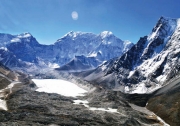 This report by ICIMOD contains an assessment of the threat facing the Hindu Kush-Himalayan region from the recent (post-1950s) and rapid formation of meltwater lakes on the surface or at the end of a large number of the region’s glaciers owing to current climate warming. Individual case studies of the catastrophic outburst (glacial lake outburst floods or GLOFs) from such glacial lakes are introduced.
This report by ICIMOD contains an assessment of the threat facing the Hindu Kush-Himalayan region from the recent (post-1950s) and rapid formation of meltwater lakes on the surface or at the end of a large number of the region’s glaciers owing to current climate warming. Individual case studies of the catastrophic outburst (glacial lake outburst floods or GLOFs) from such glacial lakes are introduced.
Early responses up to the present are described together with the methods employed, including remote sensing and geophysical field investigations. A list is provided of the several institutions with responsibility for assessing the GLOF problem within their own prescribed sections of the region.
The critical importance of continued and extended application of a wide variety of remote sensing techniques is underlined. However, it is also stressed that once a realistic ranking of the glacial lakes in order of their perceived degree of danger is firmly in place, detailed glaciological and geophysical field investigation will be required. Remote sensing application is the primary tool to achieve this in view of the serious challenges posed by high altitude, vast areal extent, and difficult accessibility.
It is emphasised that precise identification of the timing and magnitude of potential outbreak of glacial lakes cannot be achieved with the present state of knowledge. Consequently, the report aims to present a preliminary assessment as a basis for future action.
Some key recommendations presented in the report are –
- As understanding of the hazard advances, effective warnings should reach every person at risk in a timely manner. Likewise, mitigation measures applied to reduce the loss of life and property from the GLOF risk should be such that they should not create or increase the risk during and after the time that the proposed mitigation measures are being put in place.
- The early warning systems that have been installed in Nepal and Bhutan are described and warning systems employed in other countries are also mentioned. Similarly, examples of mitigation measures taken in Nepal and Bhutan are discussed.
- Regional collaboration among or between the governments in the event of transboundary disasters such as GLOF risk assessment and mitigation, as well as sharing of data and information for GLOF risk management, is essential.
- Also, there is a need to accelerate inter-governmental collaborative research on glacial hazards and GLOF risk management. The importance of national policy development in GLOF risk management is also emphasised.
- Regional centres of excellence such as ICIMOD can play a critical role in bringing knowledge to guide policy making on GLOF risk reduction. A regional convention involving relevant government authorities and expert groups is proposed to develop the next steps in GLOF risk management.
Download the report here
/articles/formation-glacial-lakes-hindu-kush-himalayas-and-glacial-lake-outburst-flood-risk